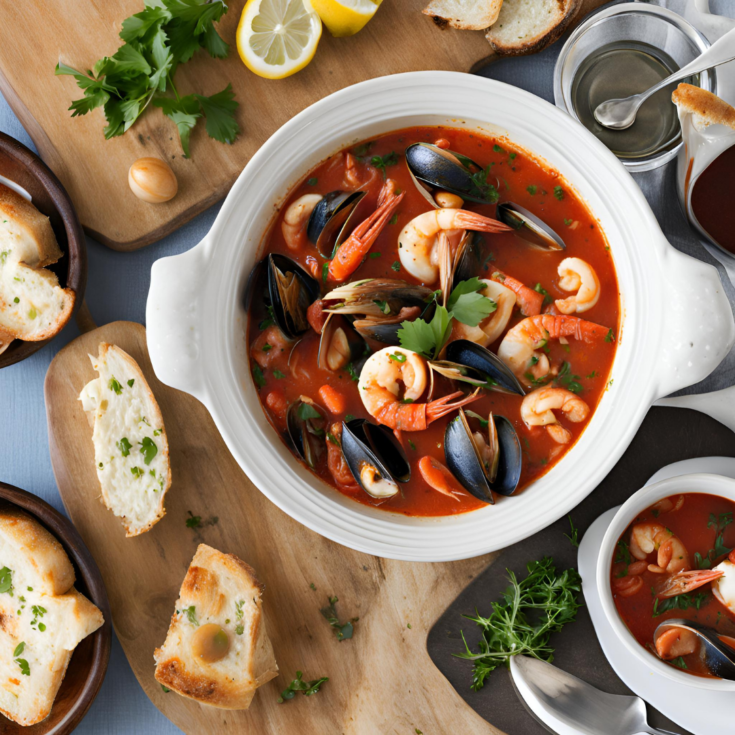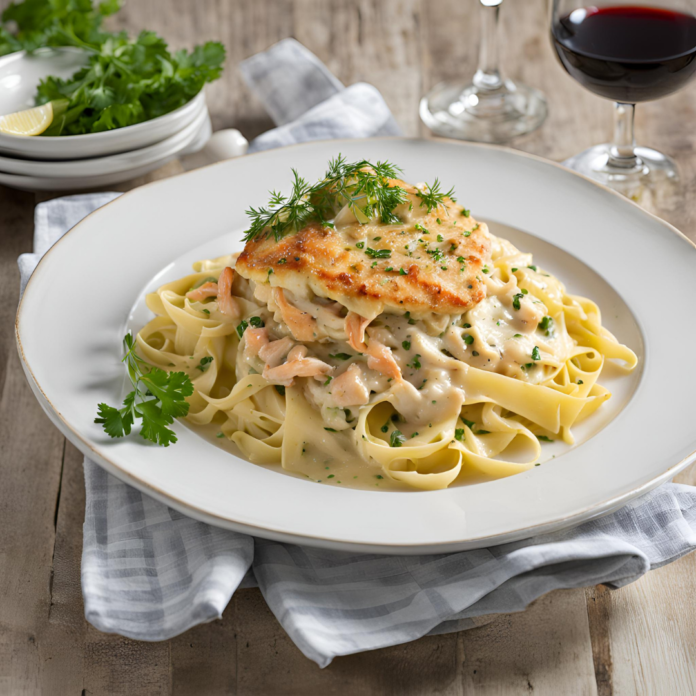Cioppino Recipe
Introduction
What is Cioppino?
Cioppino is a delightful seafood stew that hails from the Italian-American community of San Francisco. It’s a tomato-based dish packed with a variety of fresh seafood, making it a favorite for seafood lovers. The combination of flavors and textures in Cioppino is truly a culinary experience.

The History of Cioppino
This hearty stew has its roots in the 1800s when Italian fishermen settled in San Francisco. They would create this dish from the catch of the day, ensuring nothing went to waste. The name “Cioppino” is derived from the Italian word “ciuppin,” meaning “to chop,” which refers to the process of chopping up various leftovers for the stew.
Why Cioppino is Popular
Cioppino’s popularity stems from its rich, complex flavors and its versatility. It’s a dish that can be enjoyed year-round, offering a comforting warmth in the colder months and a vibrant freshness in the warmer seasons.
Preparing for the Recipe
Choosing Fresh Seafood
The key to an excellent Cioppino is the freshness of the seafood. Visit a reputable fishmonger and select the freshest catch available. If you’re unsure, don’t hesitate to ask for recommendations.
Prepping Vegetables and Aromatics
Chop the onions, bell peppers, and fennel finely. Mince the garlic to release its full flavor. These aromatics form the foundation of your Cioppino’s taste.
Stocking Up on Essential Spices
Ensure your spice rack is well-stocked. Fresh herbs are preferable, but dried herbs can be used in a pinch. Remember, the right balance of spices is crucial for that authentic Cioppino flavor.
Step-by-Step Cioppino Recipe
Step 1: Preparing the Base
Start by heating olive oil in a large pot over medium heat. Add the chopped onions, bell peppers, fennel, and garlic. Sauté until they are soft and fragrant.
Step 2: Sautéing the Aromatics
Add the red pepper flakes, thyme, and bay leaves to the pot. Stir well to combine, allowing the spices to release their aromas.
Step 3: Adding the Liquids and Simmering
Pour in the white wine, scraping up any bits stuck to the bottom of the pot. Add the fish stock, tomato sauce, and chopped tomatoes. Bring the mixture to a simmer and let it cook for about 30 minutes to meld the flavors.
Step 4: Incorporating the Seafood
Begin with the harder seafood like clams and mussels, as they take longer to cook. After about 5 minutes, add the shrimp, crab, white fish, and scallops. Cook until the seafood is just done, which typically takes an additional 5-7 minutes.
Cooking Tips for Perfect Cioppino
Balancing Flavors
Taste as you go! Adjust the seasoning with salt, pepper, and additional herbs as needed. The broth should be rich and slightly spicy.
Timing is Everything
Add seafood in stages to ensure everything is perfectly cooked. Overcooking can result in tough, chewy seafood, which you want to avoid.
Adjusting the Heat
Control the heat level by adjusting the amount of red pepper flakes. If you prefer a milder stew, reduce the amount used.
Serving Suggestions
Best Side Dishes
Cioppino pairs wonderfully with:
- Crusty sourdough bread
- Garlic bread
- A light, fresh salad
Ideal Wine Pairings
A crisp white wine like Sauvignon Blanc or Pinot Grigio complements the flavors of Cioppino beautifully.
Presentation Tips
Serve Cioppino in a large, shallow bowl to showcase the variety of seafood. Garnish with fresh parsley and a wedge of lemon for a pop of color and flavor.
Variations of Cioppino
Classic San Francisco Style
Stick to the traditional recipe with fresh, local seafood and a tomato-based broth.
Italian-Influenced Cioppino
Incorporate Italian herbs like oregano and basil, and consider adding a splash of Italian vermouth for depth.
Modern Twists on Traditional Recipes
Experiment with different types of seafood or add a touch of cream to the broth for a richer texture.
Health Benefits of Cioppino
Nutritional Profile
Cioppino is low in fat and high in protein, making it a nutritious meal. It’s also packed with vitamins and minerals from both the seafood and vegetables.
Seafood Benefits
Seafood is a great source of omega-3 fatty acids, which are beneficial for heart health. It’s also rich in iodine, selenium, and vitamin D.
Incorporating Cioppino into a Balanced Diet
Enjoy Cioppino as part of a balanced diet by pairing it with whole grains and a variety of vegetables. It’s a satisfying meal that can easily fit into a healthy eating plan.
Storing and Reheating Cioppino
Proper Storage Techniques
Store leftover Cioppino in an airtight container in the refrigerator. It’s best consumed within 2-3 days.
Reheating Tips
Reheat gently on the stovetop over low heat to prevent overcooking the seafood. Add a splash of broth or water if the stew has thickened too much.
Freezing Cioppino for Later
Cioppino can be frozen, but it’s best to do so without the seafood. Freeze the broth and add fresh seafood when reheating for the best texture and flavor.
Common Mistakes to Avoid
Overcooking Seafood
Keep a close eye on the seafood to avoid overcooking. Each type of seafood has different cooking times, so stagger their addition to the pot.
Incorrect Ingredient Ratios
Follow the recipe closely to ensure the right balance of ingredients. Too much or too little of any one component can throw off the flavor.
Not Tasting as You Cook
Tasting as you go allows you to adjust the seasoning and ensure the flavors are developing correctly.
Frequently Asked Questions About Cioppino
What Seafood Can I Substitute?
Feel free to substitute your favorite seafood or whatever is freshest. Lobster, squid, or even octopus can be great additions.
Can Cioppino Be Made Ahead?
Yes, you can prepare the broth ahead of time and add the seafood just before serving to ensure it’s perfectly cooked.
How Do I Make Cioppino Less Spicy?
Reduce the amount of red pepper flakes or omit them entirely for a milder version.
Can I Use Frozen Seafood?
Frozen seafood can be used, but fresh is preferred for the best flavor and texture. If using frozen, thaw it thoroughly before adding to the stew.
Is Cioppino Gluten-Free?
Yes, Cioppino is naturally gluten-free. Just be sure to check all labels on any packaged ingredients to confirm there are no added gluten-containing ingredients.
Conclusion
Cioppino is a flavorful and hearty seafood stew that brings the essence of the sea to your table. With its rich history and delicious taste, it’s no wonder this dish remains a favorite. Whether you’re cooking it for a special occasion or a weeknight dinner, Cioppino is sure to impress with its depth of flavor and satisfying ingredients.
Cioppino Recipe

Cioppino is a delightful seafood stew that hails from the Italian-American community of San Francisco. It’s a tomato-based dish packed with a variety of fresh seafood, making it a favorite for seafood lovers. The combination of flavors and textures in Cioppino is truly a culinary experience.
Ingredients
- Olive oil
- 1 large onion, finely diced
- 1 medium fennel bulb, fronds removed, cored and finely diced
- Sea salt
- Black pepper
- ½ teaspoon red chili pepper flakes (or more if desired)
- 1 large bay leaf
- 8 cloves garlic, pressed through garlic press
- 2 ½ tablespoons tomato paste
- 1 ½ cups white wine (pinot grigio is good)
- 2 (28 ounce) cans whole tomatoes, juices reserved and chopped/crushed into small pieces (or sub crushed tomatoes)
- 3 cups seafood stock
- 1 ½ pounds halibut (or cod), cut into 1 ½ – 2 inch chunks
- 1 pound littleneck clams, scrubbed
- 1 pound large shrimp, peeled and deveined
- 1 pound black mussels, de-bearded and scrubbed
- 1 tablespoon chopped flat-leaf parsley, for garnish
- Sliced and toasted sourdough bread, for serving on the side
- Lemon wedges (optional, served on the side)
Instructions
- Place a large soup pot over medium heat, and drizzle in about ¼ cup of olive oil; once the oil is hot, add in the diced onion and fennel, along with a couple of good pinches of salt and pepper, plus the red chili pepper flakes and the bay leaf, and stir to combine.
- Saute together for about 5-7 minutes, until the veggies begin to soften and become aromatic; then, add in the garlic and stir to incorporate, and once it becomes aromatic (about 30 seconds), add in the tomato paste and stir to combine and cook for a moment or so.
- Next, add in the white wine, the chopped/crushed whole tomatoes along with their juices (or canned crushed tomatoes, if using those instead), and the seafood stock, and stir to combine. Taste the cioppino broth and add a couple of very generous pinches of salt to taste (as it may need quite a bit), and a pinch or two of black pepper as well.
- Bring the broth to the boil, then reduce the heat and allow the tomato broth to gently simmer, uncovered, for 40 minutes.
- After 40 minutes, remove the bay leaf, and taste the broth to see if more red pepper flakes and/or salt and pepper is needed; then, with the broth vigorously simmering, begin adding your seafood to the pot starting with the halibut (or cod) pieces first, next the clams, then the shrimp, followed by the mussels. Using a wooden spoon, just barely nudge them into the broth a little bit to partly submerge them.
- Cover the pot with a lid and allow the seafood to cook for 10 minutes at a vigorous simmer, or until the clams and the mussels are opened up (take care to not over-cook to avoid rubbery seafood).
- Before serving, check to see if any clams or mussels remained closed, and if so, remove those as they are not good to eat. Drizzle a generous amount of olive oil over the cioppino and garnish with parsley, then ladle into shallow bowls and serve with toasted sourdough, as well as some lemon wedges, if desired.
Notes
- You choose your seafood: I'm using a total of about 4 ½ pounds of various types seafood for this recipe, which works well. I love the combo of clams, mussels, halibut and shrimp, but if you'd like to add scallops or crab meat, then just substitute a portion of some of the seafood, if you'd like.
- Cleaning the clams and mussels: Mussels will typically have little stringy “beards” on the sides of their shells, so just pull those off to remove them. And if the they seem a bit sandy, give them a scrub under cold, running water with a vegetable brush to clean them. Soaking clams and mussels (separately) in cold, fresh water will also help them to spit out any residual sand from their shells. Then, drain them and keep them cold in the fridge until ready to use.
- Halibut or cod: Because this cioppino is a real treat, I love to use halibut because it is meaty in texture and mild. It is quite pricey, however, so if you'd prefer to spend a little less, then opt for cod. It is also a terrific white fish to use in cioppino, with a mild flavor, and a lot less pricey.
- Make it spicy, or not so much: A spicy, garlicky tomato broth is something that I really enjoy, so I tend to add quite a bit of red pepper flakes to my pot of cioppino. I kept the amount called for in the recipe to a medium/mild level, but you can add more or less, depending on your preference.
- How to reheat cioppino: I've found that it's easy to reheat cioppino the next day (or even the day after) by ladling out an individual portion into a small sauce pan or pot, and very gently heating until nice and hot. Do not vigorously simmer the stew when reheating, as this will further cook your seafood, making it rubbery, rather than just warming it through.



